
Prerequisite Reading
We strongly recommend reading of our post “The Need for the Protestant Reformation” prior to reading this or any of the other Reformation posts we have written.

Introduction
The Protestant Reformers didn’t start out with the thoughts of beginning new denominations; their only goal was for reformation to occur within the Catholic Church. Popes, cardinals, and priests had become the subject of ridicule and mockery due to their scandalous lifestyles. Their followers, seeing their example, then felt at liberty to do the same.
The reformers’ obstacle, however, was that the corruption and immorality was so deeply ingrained, so much a part of the system, that the only solution would be a clean break from the Catholic Church.
Even though the Catholic Church was so dark, God has always had a remnant of genuine followers who were pleading for revival, asking for a restoration and a return to their primitive faith.
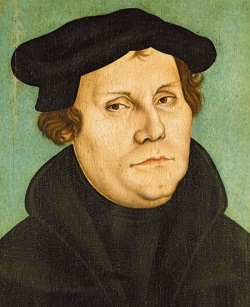
Catholic Priest
Martin Luther
Martin Luther (1483 – 1546)
► Luther was born in Eisleben, Germany (Prussian Saxony) on Nov. 10, 1483.
► He entered the University of Erfurt when he was 18.
► He graduated with a Bachelor of Arts in 1502.
► He obtained a Master of Arts in 1505.
His father by this time had become a lawyer and wanted Luther to follow him in that profession. His career choice, however, was changed when a close friend of his was struck dead by lightening. Immediately following that, Luther was caught in a violent thunderstorm, and it filled him with such terror, that he cried out:
Help! Beloved Saint Anna! I will become a monk.
Luther made good on his pledge, and on July 16, 1505, he entered St. Augustine’s Monastery in Erfurt, Germany.
Upon his entry, he found that the monastery wasn’t what he expected, as they were part of the corrupt Catholic Church, laden with debauchery and corruption of every type. One author, being discreet, said,
The practices permitted within [these monasteries] cannot be published.
► 1507: Luther was ordained as a Catholic priest.
► 1512: He received a Doctor of Theology.
► 1512: He began teaching as a faculty member of the University of Wittenberg.
► 1515: He was given the oversight of the eleven monasteries in his province.
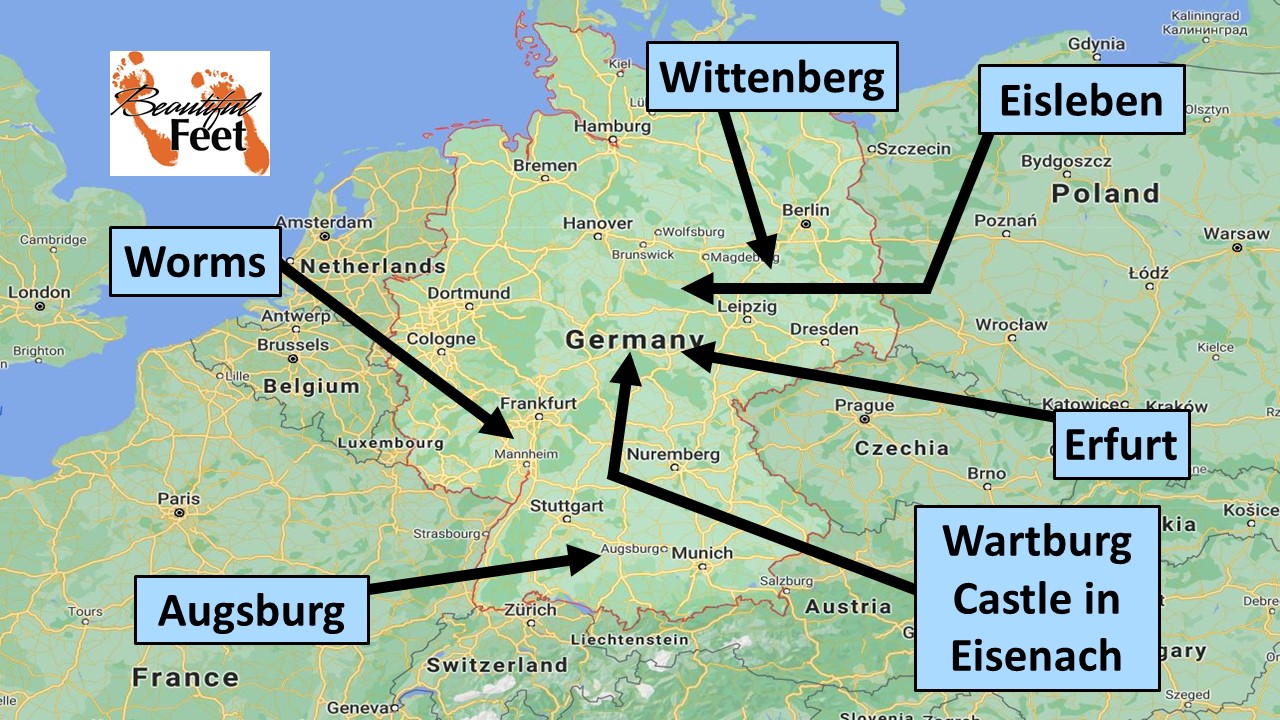
Main locations mentioned in this story
PREPARING THE REFORMER
In the fall of 1510, the monastery sent Luther to Rome. He was full of devout expectation, longing to see what the “holy” city of Rome was like. When he entered the gate to the city, he said,
Blessed Rome! Blessed Rome! Sanctified by the blood of the martyrs!
But his spiritual fervor and emotions where short-lived, as he soon saw Rome for what it was–a city wholly given over to idolatry. He witnessed people running from church to church admiring and praying before relics, as well as worshipping before the shrines of the saints.
Having heard stories in Germany of the previous pope–which seemed unbelievable–he found them to be fact. Disgusted with what he saw, as he was leaving the city he said,
Adieu Rome! Let all who would live a holy life flee from thee.

Rebuilding of Saint Peter’s Basilica
The Old St. Peter’s Basilica, built by Constantine in the 4th century, was beyond repair, and the Church of Rome initiated plans to rebuild it, but on a much grander scale. To generate necessary finances, one method the Church used was to grant indulgences in return for contributions.
Indulgences were permits, certifying that the owner had paid a certain amount of money, relieving them of having to spend time in purgatory prior to their entry into heaven. These indulgences were also sold for those already deceased, in the hopes that departed loved ones would be able to be released from purgatory sooner.
Johann Tetzel, a Dominican preacher, was one of those designated to travel through Germany selling these indulgences. His sales techniques became scandalous as he preyed upon people’s fears.
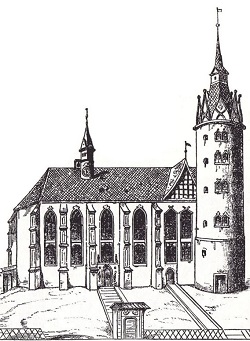
Wittenberg Castle Church
95 Theses
Martin Luther, appalled at this practice, wrote a letter to Albrecht von Brandenburg, Archbishop of Mainz, expressing his complaint. With this letter, Luther also included his 95 Theses, which were a list of proposals he recommended for reform within the Church.
The archbishop didn’t respond to his letter, so on October 31, 1517, Luther took his proposals for reform to the people. This was done by him “publishing,” or nailing his 95 Theses to the door of All Saints’ Church (commonly referred to as Castle Church) in Wittenberg, Germany. By so doing, Luther was challenging the Church to defend its action.
Copies of Luther’s work were printed, and within 14 days it was found in universities and cities throughout the land.
Luther the Reformer
Luther’s challenge was a threat to the income of thousands. A lot was to be forfeited if his voice wasn’t silenced.
As he looked more intently at the Scriptures, he saw no sanction for the claims for an office of “pope.” This was causing, in Luther’s mind, a total breakdown of the structure on which the Catholic Church was built.
Luther on Trial in Augsburg
To silence Luther, the Pope ordered him to appear before him in Rome, but knowing that Luther would never return alive if he went, Prince Frederick of Saxony stepped in and arranged for the case to be heard in Augsburg, Germany.
The Pope sent a representative to question Luther and to get him to recant, and when threats, bribes, and entreaties didn’t work, the representative said:
What! Do you think that the Pope cares for the opinion of a German boor like you! The Pope’s little finger is stronger than all Germany. Do you expect your princes to take up arms to defend you?
Once the Pope heard the results of the trial, he demanded that Frederick send him to Rome. Fredrick knew that Luther’s life would be at stake if he obeyed, so he dismissed the Pope’s order. Not able to force Luther to appear before him, the Pope then wrote a bull, excommunicating him and condemning him and all his writings.
Once Luther received the bull, he publicly burned it in the great square of Wittenberg, an act which was his definite break with the Catholic Church.
Trial at Worms, Germany (Diet of Worms)
German princes demanded that Luther receive a fair hearing, so an assembly of leaders from the Holy Roman Empire was conducted in 1521.
Luther was given the opportunity to renounce or reaffirm his views. In the end, Luther refused to recant, and the Emperor (Charles V) issued the Edict of Worms, a decree which condemned Luther as “a notorious heretic” and banned citizens of the Empire from propagating his ideas. Although the Protestant Reformation is usually considered to have begun in 1517, the edict signaled the first overt schism.
Prince Frederick had given Luther a promise of safe passage from Wittenberg to and from Worms. This was his promise that he would protect him from the authorities of the Pope. But, as with John Hus, who also received such a promise but was immediately imprisoned and later burned at the stake, there was also pressure placed upon Frederick to go back on his word, when he was told:
Honour was nothing; morality was nothing; where the interests of orthodoxy were compromised.
Frederick, however, remained true to his word, and when he heard of a plot to assassinate Luther, he sent soldiers to pick him up and bring him safely to the Wartburg Castle.
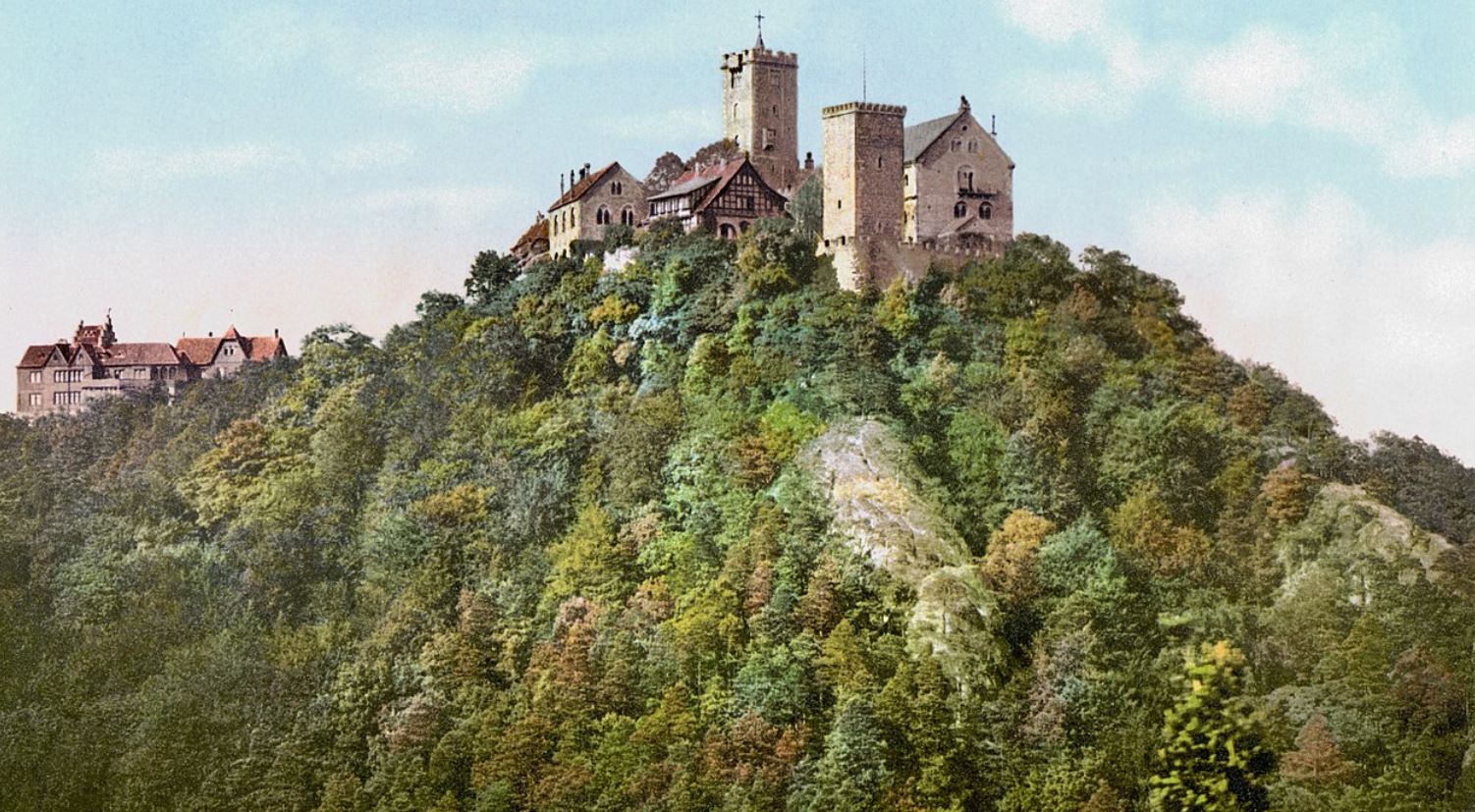
Wartburg Castle overlooking the city of Eisenach, Germany
Luther at Wartburg Castle
During Luther’s stay at Wartburg Castle he translated the Bible into German, completing it in 1532.
First Lutheran Martyrs
Because of rising public support for Luther among the German people, and the protection offered by certain German princes, the Edict of Worms was never enforced in Germany. However, in Belgium, Luxembourg, and the Netherlands, the Edict was enforced against Luther’s most active supporters, with two monks–Jan van Essen and Hendrik Vos–being burned at the stake on July 1, 1523.
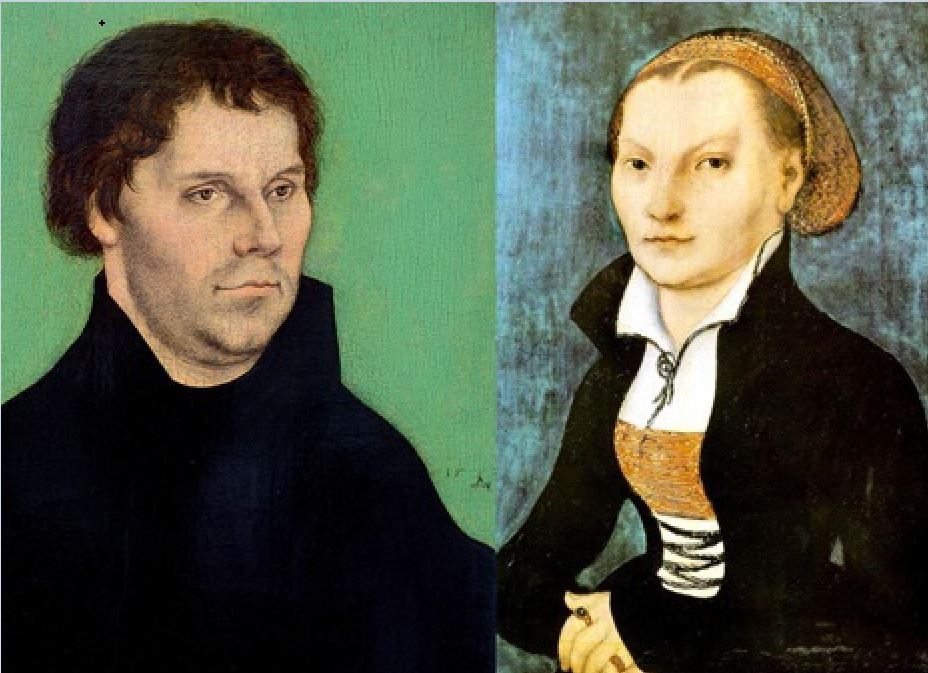
Martin Luther and Katharina Von Bora
Luther Marries
Breaking Catholic tradition of celibacy, Luther declared the doctrine of celibacy an invention of Satan, and in 1525 he married a nun, Katharina von Bora, and they had 6 children.
Establishing the Lutheran Church
The remaining years of Luther’s life he
► Wrote over 40 hymns
► Wrote catechisms
► Wrote liturgy for church services
► Engaged in debates with other reformers
Sources
► Acts and Monuments by John Fox
► Martin Luther by Wikipedia
► Martin Luther: The Great Reformer by Edwin P. Booth
► Revivals Their Laws and Leaders by James Burns
► The Life of Martin Luther by Chevalier Bunsen
► The Reformation in Germany by Henry C. Vedder
► The Ten Greatest Revivals Ever by Elmer Towns
Return to List of Revival Stories
Chet & Phyllis Swearingen
(260) 920-8248
romans1015@outlook.com
Beautiful Feet
P.O. Box 915
Auburn, IN 46706

